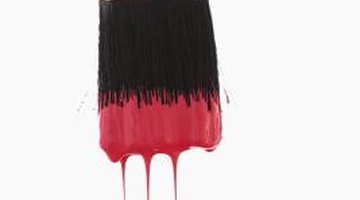Painting Fiberglass Reinforced Plastic Textured Wall Paneling
Fiberglass reinforced panels consist of sheets of special plastics blended with finely-woven glass fibers for extra strength and durability. These panels are not only waterproof but also easy to clean making them a common choice in kitchens, bathrooms and commercial spaces. While most fiberglass panels feature integral color applied by the manufacturer, you may be able to paint these panels prior to or after installation to freshen them up or give them a brand new look.
Overview

In general, most fiberglass reinforced plastic (FRP) textured wall panels are not designed to be painted. Instead they come with built-in color added at the factory which helps to minimize the impact of scratches and other surface damage. In addition, they are specifically designed with a nonadherable surface. This surface makes them easy to clean and helps prevent stains and discoloration, but also prevents paint from sticking effectively without a bit of extra work. Though this is true of most panels, some FRP manufacturers produce panels designed for painting. Always check with the manufacturer before you buy if you're looking for panels made for easy painting.
Preparation is Key
Despite their nonadherable surface, all FRP panels can be painted with proper preparation. Start by cleaning and degreasing the surface according to the manufacturer's recommendations. Next, sand the entire panel to remove its smooth finish and create a rough texture. It is not necessary to sand out the texture of the panel, only to roughen the surface. Finally, wipe the panel with a rag dipped in denatured alcohol to remove sanding dust and create a clean surface for painting. Take the time to remove all dust within grooves or other depressed areas of the textured panel for best results.
Paint Selection Matters
When you're ready to paint, FRP manufacturers recommend choosing a high quality acrylic or epoxy paint for textured fiberglass wall panels. Low quality paint or latex paint is likely to chip, peel or flake, leading to poor results. Pick a high-end acrylic for indoor use, or a high quality epoxy for outdoor application or use in caustic environments. These paints can be applied using a brush, rollers or sprayers depending on personal preference.
Warnings and Dangers
One of the biggest dangers associated with painting fiberglass textured wall panels is in preparing these panels for painting. Sanding FRP can release fine fibers into the air, which can pose health hazards and impact air quality. Sand these panels outdoors if possible and wear a respirator to avoid breathing fibers. Be aware that sanding before painting may change the texture of the panel which could impact its appearance. Despite this risk of texture change, sanding is necessary to allow the paint to stick. Attempting to paint FRP without proper preparation will likely lead to poor results.
References
- Crane Composites: Frequently Asked Questions
- Illinois Department of Public Health: Fiberglass
- Akzo Nobel: Surface Preparation and Priming - Fiberglass/Gelcoat
- Crane Composites: FRP Encyclopedia
- Fiberglass Repair and Construction Handbook; Jack Wiley
Writer Bio
Emily Beach works in the commercial construction industry in Maryland. She received her LEED accreditation from the U.S. Green Building Council in 2008 and is in the process of working towards an Architectural Hardware Consultant certification from the Door and Hardware Institute. She received a bachelor's degree in economics and management from Goucher College in Towson, Maryland.
Photo Credits
- Martin Poole/Digital Vision/Getty Images
More Articles



